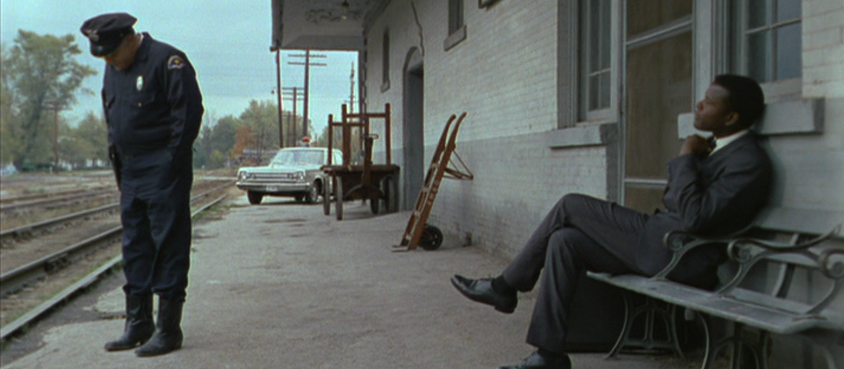
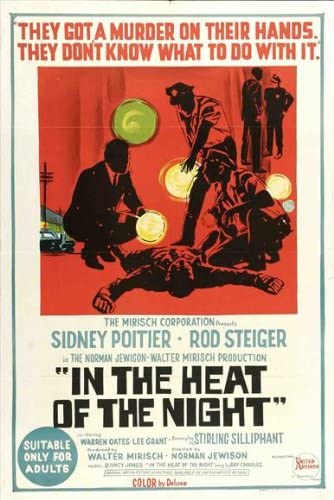
“I got the motive which is money and the body which is dead.”
Norman Jewison’s In the Heat of the Night won the Academy Award for Best film in 1967, beating out innovative New Hollywood films Bonnie and Clyde and The Graduate, as well as Guess Who’s Coming to Dinner?—another racially-charged drama starring Poitier—and the forgettable musical Dr. Doolittle. Retrospectively, any of the films save the last would have been good choices. The enduring appeal of In the Heat of the Night is in its nuanced consideration of racial relations at a tense time in United States history (the Civil Rights Act was signed into law three years prior in 1964). At the time of its release, lead actor Sidney Poitier was one of the only African-American Hollywood stars, and the film was the first to feature a black detective.
The film’s basic narrative is that of a conventional murder-mystery—its social commentary is entirely contained within the confines of an otherwise genre-conforming picture. So, while the film’s criminal investigation would still technically “work” without the element of racial tension, that additional element is precisely what has led to its longevity, as it is unfortunately still strikingly relevant in today’s social climate. While the film does have several overtly racist characters, the central characters’ racial biases are considerably less prominent, revealed mostly in subtle hints and infrequent moments of lost temper throughout the film, relying on a stellar cast to inhabit their roles. Many of the cues are conveyed to the viewer through the thoughtful delivery of lines, physical actions, and facial expressions of the actors, as well as careful camerawork. The core duo of Sidney Poitier and Rod Steiger both shine in their roles (Steiger won the Oscar for Best Actor, beating out nominees from three of the four other films nominated for Best Picture).
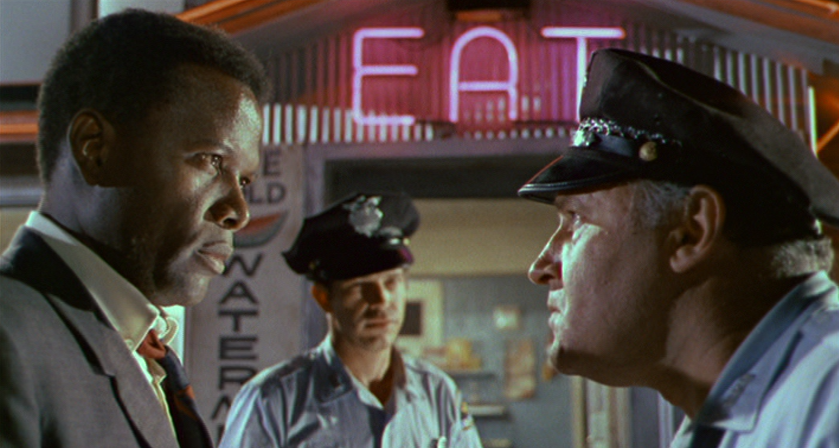
Soon after the film begins, Officer Sam Wood (Warren Oates) discovers a dead man lying in the street. When Chief Gillespie arrives, he asks Sam if the man had a wallet or any form of identification, Sam says, “That’s the first thing I look for, Chief. But whoever fixed him must have took it.” Minutes later, when Sam arrests Detective Virgil Tibbs (Poitier) at the train station, he opens Tibbs’s wallet only enough to comment on how much money is inside of it before putting it into his own pocket and assuming the man’s guilt. He never searches for any identification and never even tells Tibbs why he is being arrested. Once the film is underway, it is easy to overlook the fact that the plot of the film would not exist if Wood had discovered Tibbs’s badge or if Tibbs would have spoken up when being arrested. However, Tibbs remains silent until he is asked his name at the police station.
At the station, Gillespie tries to remain in control of the situation, but almost as soon as he starts talking to Tibbs he realizes this won’t be routine. When Tibbs menacingly promises to be “no trouble at all” Gillespie’s reaction immediately changes from bemused to uncertain. He seems disconcerted by the articulate black man that is in his station; Tibbs does not appear to be a murderer, and his stoic demeanor and succinct answers to the chief’s rhetorical questions begin aggravate the chief. Once Tibbs reveals that he has money because he works as a police officer, Gillespie is dumbstruck; he paces, mute, finally emitting a small chuckle of disbelief. He takes his anger out on Officer Wood. As Wood looks at the badge, Gillespie yells at him, “Yeahhh! Oh, yeah!” The look on Gillespie’s face reminds me of a parent sternly disciplining a child for carelessly doing something that reflects poorly on the parent, imbuing the simple statement with a subtext that roughly translates as: “I wish I could dropkick you right now but I am responsible for your idiotic conduct.”
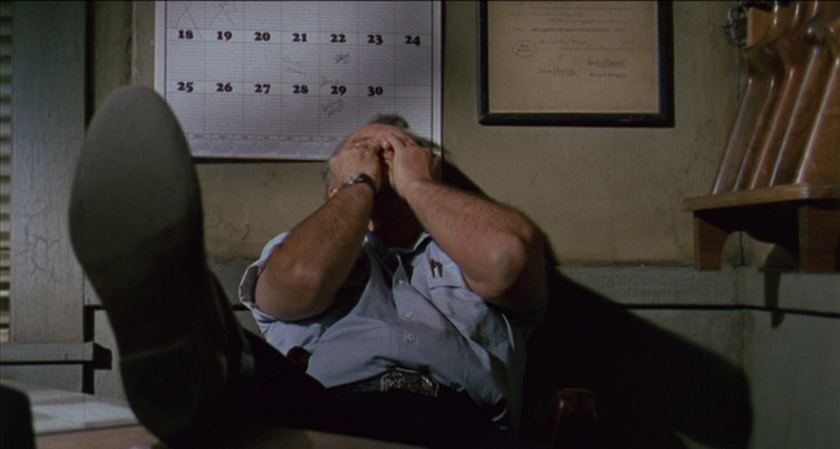
As Tibbs is about to leave to go back to the train station, Gillespie asks him to take a look at the victim’s body, because he is Philadelphia’s leading homicide investigator. Although his own chief had suggested that he do so over the phone, Tibbs only decides to do so when Gillespie shows him respect by referring to him as “Officer.” But Gillespie’s ingrained bias eventually overwhelms his sense when Tibbs repeatedly uses his intuition and expertise to counter Gillespie’s claims. In a rapid outburst, he uses the dreaded racial slur and makes fun of the name “Virgil”, asking Tibbs what they call him in Philadelphia. Tibbs’s response is the iconic line: “They call me Mister Tibbs!”
The film works on three levels: polemical social critique, relational drama, and conventional whodunit mystery. Peeling back the layers from overtly racist characters, to the nuanced performance of Steiger as the complex Gillespie, there is also a strain of bias in the character of Virgil Tibbs. When he finally solves the case, he admits to being hung up on the personal conflict he has with the owner of the plantation.
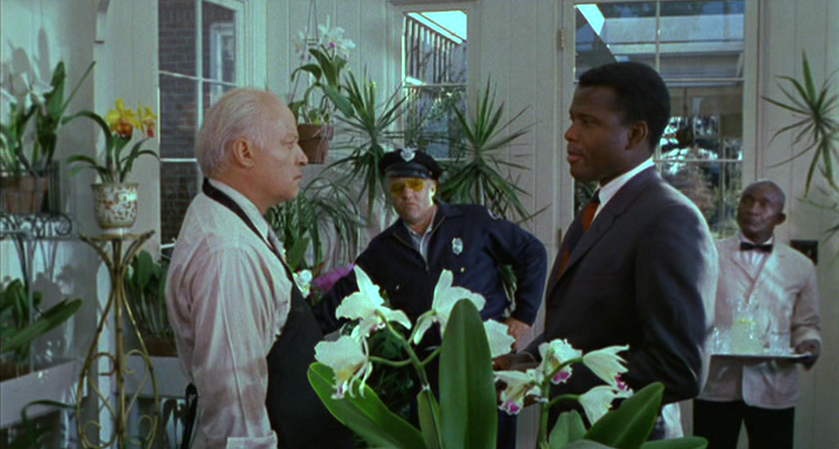
The plot is undergirded by an abstract connection between the town’s economic deprivation and systemic racism. The murdered man was an industrialist who planned to build a factory in Sparta, an enterprise that would have employed many of the African-Americans that were currently working on the plantation owned by the refined Endicott—a politically influential man whose racism is masked by gentility but is all the more terrifying when it is glimpsed because of the facade. Tibbs matches Endicott’s couth by discussing orchids with him in his greenhouse, and the old man’s casual racism makes it way into the conversation. “Why isn’t that remarkable, that of all the orchids in this place you should prefer the epiphytic […] because, like the negro, they need care, and feedin’, and cultivatin’. And that takes time. That’s something you can’t make some people understand.” His comment does not seem meant to instigate or offend Tibbs; he says it with a sense that his statement is objective and not an opinion open to question. A lasting image from the film occurs when Endicott slaps Tibbs in the face for daring to question him about the murdered industrialist. Tibbs raises his own hand and slaps the man right back, playing against audience expectations of the era. The reactions are telling.
Endicott: “Gillespie?”
Gillespie: “Yeah.”
Endicott: “You saw it.”
Gillespie: “I saw it.”
Endicott: “Well, what are you gonna do about it?”
Gillespie: “…I don’t know.”
Endicott: “I’ll remember that.”
Endicott (to Tibbs): “There was a time… when I could’ve had you shot.”
Gillespie’s complex reaction is inscrutable and indicative of inner conflict. Throughout the film, one of the tics that Steiger gives his character was the habit of rapidly chewing gum, chomping his jaw almost to the point of annoyance. There are several moments throughout the film (this being one) where Gillespie’s jaw loses its rhythm—this is not routine for the chief; he actually has to think about how to handle the situation. After this scene, Tibbs subsequently becomes focused on bringing down Endicott, as the personal altercation formed his opinion on the case. He becomes entrenched in the quest to bring down the white man who is subjugating numerous African-Americans by forcing them to work in his cotton fields.
But the film never stumbles on account of its social critique; it never becomes “preachy” (a problem which many such films struggle with today)—it always fits within the overarching narrative of solving the crime. Jewison and cinematographer Haskell Wexler do an excellent job of imbuing the film with subtle visual interactions as well. Whenever Tibbs examines the dead body, the camera is up close, and we see the contrast between the dark hands of Tibbs and the pale skin of the dead man, as the incompetent doctor looks on. A similar framing occurs when Tibbs examines the fingers and hands of the handcuffed suspect, and the arrested man’s humiliation overcomes him and he lashes out at Tibbs. In the previously discussed scene we have the contrast of Tibbs hand striking the white face of Endicott, and as the film concludes with the murder solved, Tibbs and Gillespie finally clasp their hands firmly in farewell.
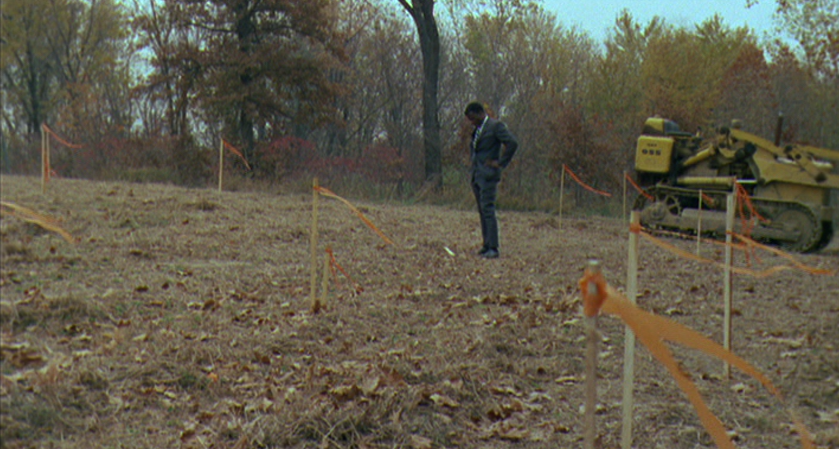
The relationship between Tibbs in Gillespie is what really elevates the film. Steiger’s methodically acted Gillespie is beady-eyed and high strung, chomping his gum as he learns from the situation where he is not the most talented lawman in town yet he is not as ignorant as the townspeople that wish ill toward Tibbs. Poitier plays off of Steiger and the peripheral cast with a stoic self-confidence and repressed rage in the hostile Southern setting. Throughout the film, the two men’s interactions are almost entirely focused on the case. In a later scene, they are in Gillespie’s living room, and their conversation meanders into talking about their personal lives. The conversation forces Gillespie to realize that the man sitting across from him, whom his town deems as an unwelcome outsider, is more similar to him than any of those people. It’s all very subtle, and it’s not as if Gillespie has an epiphanic moment and changes immediately; in fact, he even gets defensive at one point which breaks up the touching moment.
This film deserves to be dissected and analyzed, and is one of the lasting achievements of its era. Film students can have a field day breaking down the social commentary and the politics of the era, or discussing Gillespie’s physical posturing when in the presence Tibbs, etc. It is simply a well-made film. But the layman doesn’t care about any of that; it should be seamlessly integrated into a film, and it is.